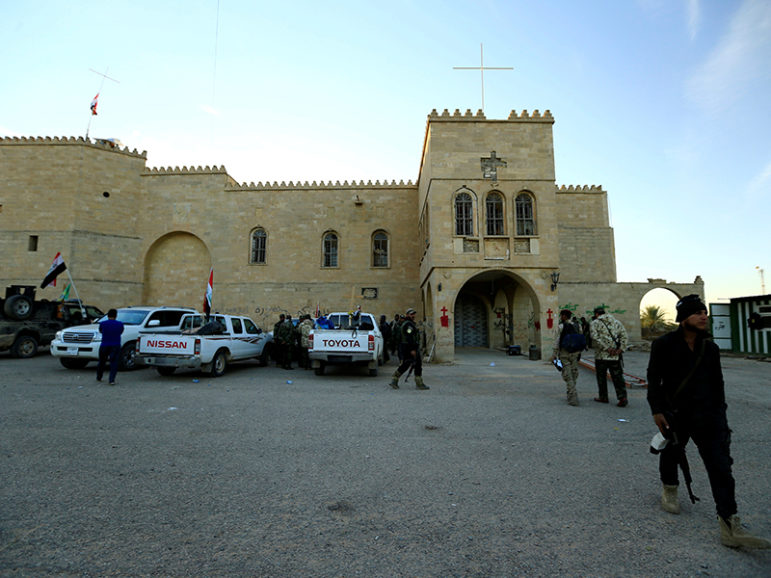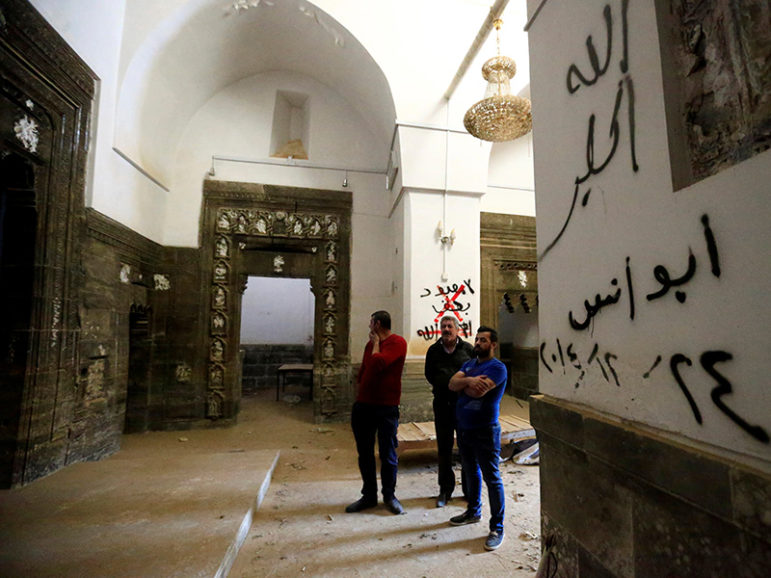
Fighters from the “Kataeb Babylon”, a group of Christian fighters who fight alongside the Hashd Shabi, Shi’ite fighters, walk at the Mar Behnam monastery after the town was recaptured from the Islamic State, in Ali Rash, southeast of Mosul, Iraq on November 21, 2016. Photo courtesy of Reuters/Thaier Al-Sudani
KHIDIR ILYAS, Iraq (Reuters) – The history pages of Iraq’s Christian community lie in charred fragments on the floor of a fourth-century monastery near Mosul which Islamic State militants ransacked during a two-year occupation that ended over the weekend.
The jihadists at the Mar Behnam monastery burned a collection of books about Christian theology, scraped off inscriptions written in Syriac – the language used by Jesus – and demolished sculptures of the Virgin Mary and the monastery’s patron saint.
They removed the site’s crosses and tried to erase any mention of Behnam, the son of an Assyrian king who, according to popular legend, built the monastery as penance for killing both his children after they converted to Christianity.
[ad number=“1”]
“Their fundamental goal was to destroy Christian history and civilization in the Nineveh plains,” Duraid Elias, commander of the Babylon Brigades, a Christian militia that helped retake the site, told Reuters during a visit on Monday.
The Nineveh plains, a sprawling region north and east of Mosul, are a mosaic of ethnic and religious communities with roots dating back to ancient Mesopotamia.
The Sunni Muslim hardliners of Islamic State have targeted the adherents and religious sites of those minority groups across the area, which it seized in 2014 during a blitz across Iraq and neighboring Syria.

People inspect the Mar Behnam monastery after the town was recaptured from the Islamic State, in Ali Rash, southeast of Mosul, Iraq November 21, 2016. Courtesy of REUTERS/Thaier Al-Sudani
At the time, the group issued an ultimatum to Christians: pay a tax, convert to Islam, or die by the sword. Most fled towards the autonomous Kurdish region, including a few dozen monks who left Mar Behnam with only the clothes on their backs.
As a 100,000-strong alliance of Iraqi forces now attempts to oust Islamic State from the city of Mosul, the scale of destruction in nearby Christian areas is gradually being documented.
The jihadists had converted Mar Behnam, Iraq’s largest monastery, into a headquarters for the Hisba — morality police, which enforced strict rules against such things as smoking, men shaving their beards and women baring their faces in public, according to Elias.
[ad number=“2”]
A sitting room had been turned into a medical clinic, and the monks’ bedrooms were used to hold transgressors. A remote corner of the complex was filled with dozens of satellite dishes the commander said had been confiscated from residents nearby.
Islamic State graffiti covers the monastery’s walls, including the group’s motto: “Remaining and expanding.” Another scrawl includes the date Dec. 24, 2014 – one of two Christmases the jihadists spent in control of the site.
Five weeks into Iraq’s long-awaited offensive to retake Mosul, which itself once had a sizable Christian population, the city is nearly surrounded, but government forces have established only a small foothold in a few eastern districts.
Fighting has laid waste to entire towns and villages, while Islamic State booby-traps, including in and around the monastery, mean it could be months or even years before some residents can return home.
Eye for an eye
The Baghdad-backed Babylon Brigades are the type of force that Iraq’s Western allies have pushed to participate in the Mosul campaign in an attempt to secure local support for the expected rollback of Islamic State.
The Christian fighters at Mar Behnam monastery on Monday wore an assortment of military uniforms, carried large wooden crosses in their pickup trucks and flew banners including, incongruously, flags used by Iraq’s powerful Shi’ite Muslim militias.
Many of the gunmen sported black headbands declaring devotion to Jesus or the Virgin Mary, and one had affixed a religious icon to his bulletproof vest, next to a hand grenade and two single bullets.
[ad number=“3”]
Elias, the commander, said his unit had fought alongside the Iraqi army to retake the monastery and the village of Khidir Ilyas where it is located. But the regular troops had since departed, leaving his men in apparent control of the area.
After showing Reuters around the site as gunfire rang out in the distance, he welcomed six new volunteers into the Babylon Brigades, issuing them with uniforms and weapons in exchange for a simple vow to protect the area.
His men, part of a dwindling population of Arab Christians across the Middle East, are driven by a desire to keep their community alive after Islamic State threatened to destroy it for good.
“We are proving to the world that Christians are not weak. We are stronger than they imagined,” said Elias.
He told Reuters his forces had so far demolished three or four homes thought to belong to Islamic State fighters in Khidir Ilyas to keep them from ever returning.
“There are others. We are going one by one: for every Christian house they blew up, we blow up a house next to it,” he said from atop the monastery, pointing out one such pair of buildings.
“This is war. An eye for an eye and a tooth for a tooth.”




